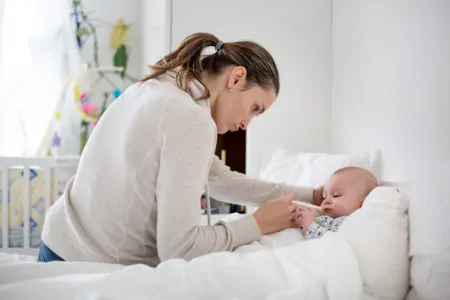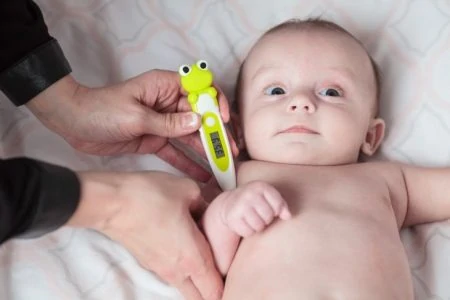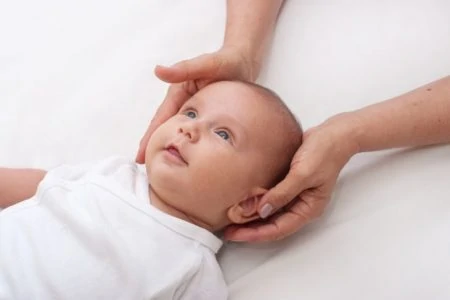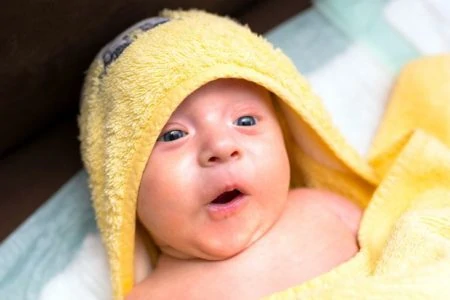When your baby is sick, it feels like the world stops. Whether it’s a stomach bug or a nasty cold, the threat of dehydration is always lurking in the background. But what are you supposed to do when your little one is too young for water?
There are several ways to help your baby fight off dehydration, but parents often ask us: “Can I give my baby Pedialyte?”
The short answer is yes, but there are rules. If your baby is under 1 year old, you need to proceed with caution and always get the green light from your pediatrician first.
Key Takeaways
- Pedialyte combats dehydration caused by vomiting or diarrhea by quickly replacing lost fluids and electrolytes.
- Always consult your pediatrician before giving Pedialyte to infants under 1 year old to get the correct dosage.
- Watch for dehydration signs like dry diapers, a lack of tears when crying, and a sunken soft spot (fontanel).
- Never mix Pedialyte with formula, juice, or water, as this disrupts the precise sugar-to-electrolyte balance needed for rehydration.
What Is Pedialyte?
Pedialyte is an oral rehydration solution (ORS) scientifically designed to replace fluids and minerals lost during illness, heat exposure, or intense activity. It uses a precise balance of sugar and electrolytes to help the body absorb water quickly. This makes it a go-to tool for babies struggling with vomiting or diarrhea.
There are several different versions on the shelf these days (1):
- Pedialyte Classic: The standard liquid formula found in most medicine cabinets. It replaces lost zinc and electrolytes and comes in unflavored or flavored options.
- Pedialyte AdvancedCare: This version includes PreActiv Prebiotics. These help support your baby’s digestive system while rehydrating, which is helpful during stomach bugs.
- Pedialyte AdvancedCare Plus: This packs the same prebiotics as the AdvancedCare line but includes 33% more electrolytes for maximum rehydration power.
- Pedialyte Sparkling Rush Powder: A fizzing powder option that focuses on balancing electrolytes and sugar without artificial colors.
- Pedialyte Freezer Pops: These are frozen electrolyte treats. While great for older kids, they are generally not recommended for infants due to the choking hazard and temperature.
When Is Pedialyte Safe to Use?
Medical opinions vary slightly on the exact starting age, but some doctors may approve Pedialyte for babies as young as 3 months if medically necessary.
However, the golden rule remains: Always consult your pediatrician before giving Pedialyte to a baby under 1 year old.
While it is safe in moderation, it is not a juice substitute. Even if your baby loves the taste, treat it like medicine, not a beverage.
In clinical practice, I only recommend using Pedialyte or other oral rehydration fluid during illnesses with excessive fluid loss. In most cases, this occurs with gastroenteritis: vomiting with or without diarrhea.During such an illness, electrolytes and fluid are lost, so it is important that both are replaced. During profuse vomiting, infants often have difficulty tolerating breast milk and formula. Oral rehydration solutions are a great way to provide fluids that are less irritating during this phase of the illness. The AAP has the following detailed information on electrolyte solutions here.
Editor's Note:
Dr. Leah Alexander, MD, FAAPWhy Give a Baby Pedialyte?
Viruses are the usual suspects behind vomiting and diarrhea in infants. While it is rarely caused by something they ate, persistent symptoms can signal a bigger issue.
Take Note
Infants lose fluid rapidly when sick. They might refuse the breast or bottle because they feel nauseous, gassy, or cramped. This creates a dangerous cycle where they need fluids but refuse to drink.
Your goal is to rehydrate them before complications set in. Pedialyte is often easier for an upset tummy to digest than formula or plain water, especially during the active vomiting phase.
Just remember that Pedialyte treats the symptom (dehydration), not the illness. It replenishes the body, but it won’t cure the virus itself.
Warning
Dehydration in Babies
Dehydration happens when the body loses more fluid than it takes in. Along with water, your baby loses essential minerals. This status can change from mild to dangerous very quickly in small bodies.
Spotting the signs isn’t always intuitive (2). Here is what you need to look for.
Early to moderate signs include:
- Withdrawal: Your baby seems less playful or interested in their surroundings.
- Dry crying: Fewer or no tears appear when they cry.
- Dry diapers: For infants, fewer than six wet diapers a day is a red flag.
- Watery stool: Diarrhea looks like you “turned on a faucet.” This is distinct from the normal loose stool of breastfed babies.
- Constipation: Alternatively, they may have fewer bowel movements due to a lack of fluids.
- Sunken fontanel: The soft spot on the top of the head appears dipped or curved inward.
- Dry mouth: The lips and tongue look sticky or dry.
Severe signs of dehydration include:
- Extreme drowsiness or lethargy.
- Sunken eyes.
- Cool, discolored hands or feet.
- Extreme fussiness.
- Only one or two wet diapers in 24 hours.
- Skin that stays wrinkled when pinched.
Giving Pedialyte to Breastfed Infants
If you are breastfeeding, don’t stop. Breast milk is tailored nutrition that contains antibodies specifically made to help your baby fight that virus. It comforts them and can actually speed up recovery (3).
However, some babies develop temporary lactose intolerance during stomach bugs. If you notice symptoms lingering, try cutting dairy from your diet to see if it helps your baby’s digestion until the illness passes (4).
Try nursing for shorter periods but more frequently. This prevents overfilling an irritated stomach, which can trigger more vomiting. Aim for a session every two hours.
Between nursing sessions, you can offer Pedialyte:
- Dosage: Offer 0.15 to 0.3 fluid ounces (5 to 10 milliliters).
- Method: Use a syringe or teaspoon every five minutes (5).
If your baby vomits, wait about eight hours after the last episode before returning to a normal nursing schedule. In the meantime, continue offering small sips of Pedialyte every five minutes to keep them hydrated.
I recommend that parents wait 30 minutes to an hour after a vomiting episode before offering large amounts of fluid. This gives the stomach a chance to “settle” and reduces the likelihood of vomiting immediately after trying to drink fluids.
Editor's Note:
Dr. Leah Alexander, MD, FAAPGiving Pedialyte to Formula-Fed Infants
For formula-fed babies, you may need to pause the formula temporarily if they cannot keep it down. Just like with breastfed babies, offer Pedialyte in tiny amounts (0.15 to 0.3 fluid ounces) via syringe or spoon every five minutes. Once they can keep liquids down without vomiting, you can slowly reintroduce formula.
If your baby uses a standard dairy-based formula, asking your doctor about switching to a soy formula during the diarrhea phase might help. This avoids lactose, which can be hard to digest during gastroenteritis, and may help firm up stools.
Worried about vomiting starting up again? Spoon-feed the formula initially. This forces the baby to eat slowly, preventing their stomach from getting overwhelmed.
Watch Out
Giving 1-Year-Olds Pedialyte
If you are breastfeeding or formula-feeding a toddler over 1 year old, the guidelines are similar. Offer small sips of Pedialyte every 15 minutes. Use a syringe, spoon, or a small cup.
If your toddler still seems sluggish or dehydrated despite your efforts, call your doctor immediately.
Side Effects of Pedialyte
While rare, Pedialyte can have side effects. Most babies tolerate it well, but some reactions can occur.
The most common issue is nausea or vomiting, usually caused by drinking it too fast. Counter this by offering only small sips, never more than two teaspoons at a time (6).
Severe side effects are uncommon but can include:
- Dizziness (hard to spot, but look for unsteadiness).
- Swelling in the feet or ankles.
- Rapid mood swings (fussiness followed by lethargy).
- Restlessness.
- Seizures (extremely rare).
Allergic reactions are also possible. Watch for:
- Itching or swelling of the face, tongue, or throat.
- Hives or rashes.
- Labored breathing.
- Severe dizziness.
What To Do About Side Effects
Mixing Pedialyte with Other Drinks
If your toddler hates the salty-sweet taste of Pedialyte, you might be tempted to mix it with juice or soda to mask the flavor. Don’t do it.
I see this Pedialyte “taste aversion” in toddlers very often. In such cases, I recommend that parents give electrolyte-enhanced water or coconut water. Both have electrolytes, are low in sugar, and have little to no flavor. However, I do not recommend this for babies under the age of 1.
Editor's Note:
Dr. Leah Alexander, MD, FAAPPedialyte is a specific chemical formula. It relies on a precise ratio of sugar to electrolytes to push water into the body’s cells. Adding sugary juice or soda ruins that ratio.
Excess sugar can actually pull water into the intestine, which creates more loose stools (7). This defeats the purpose and can make dehydration worse.
FAQs
Stay Hydrated
Watching your baby struggle with a fever or stomach bug is one of the hardest parts of parenting. When fluids stay down, recovery speeds up, but dehydration is a serious risk that requires quick action. Keep an eye out for dry diapers and tearless cries.
Pedialyte is a powerful tool to turn the tide against dehydration, even for babies under 1 year old, provided you have your doctor’s approval. Always ask about the correct dosage for your baby’s specific weight.
The AAP offers great additional advice on managing stomach bugs at home.
So, can you give your baby Pedialyte? Yes, but do it carefully, slowly, and under guidance.











